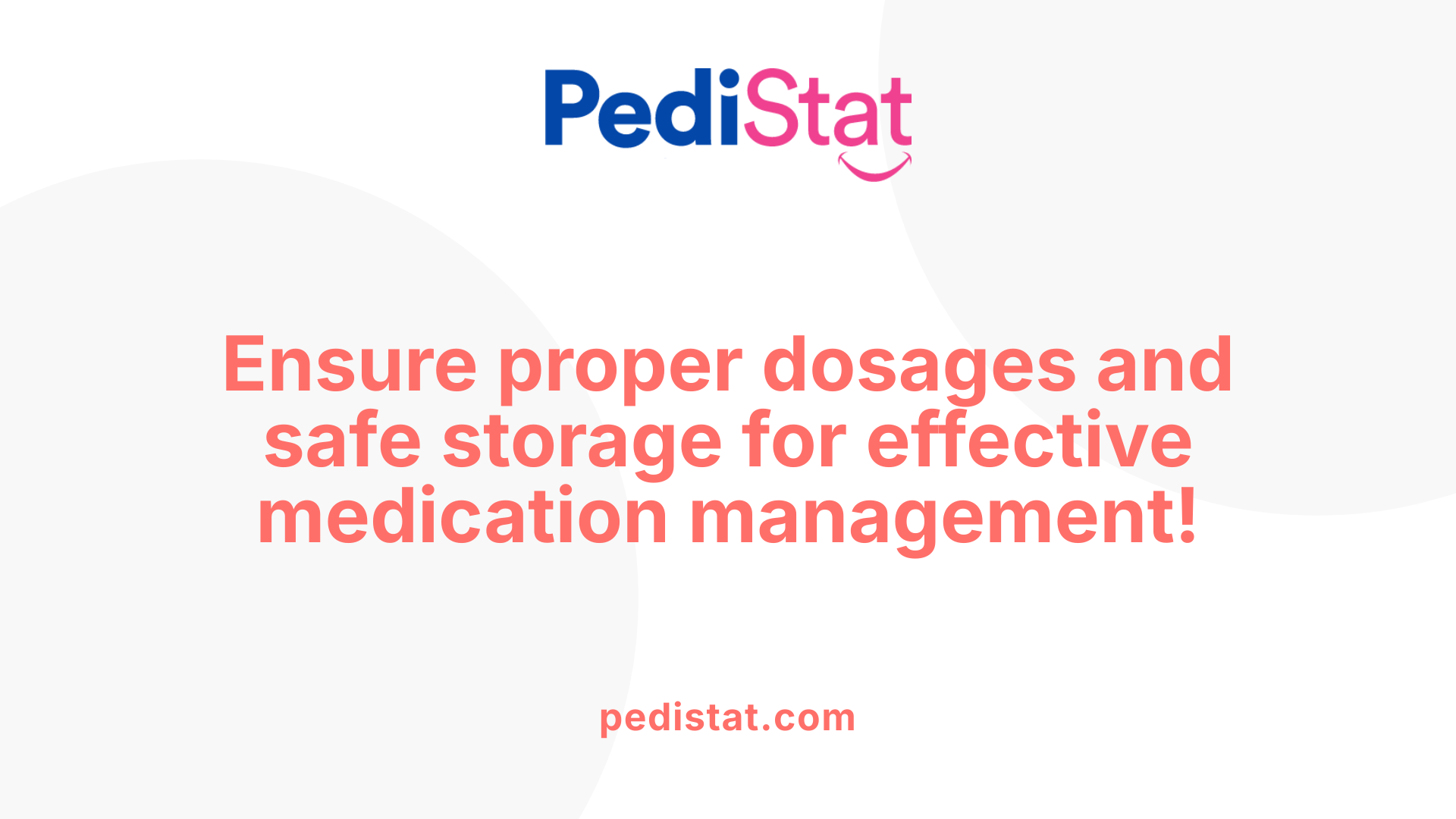Tips for managing medication schedules for children at home

Introduction
Navigating medication schedules for children can often feel like a daunting task for parents. Yet, establishing an effective medication routine is crucial for ensuring the health and wellbeing of your child. In this article, we will explore practical strategies for managing your child's medication schedule at home, covering everything from safety tips and organizing techniques to communication with healthcare providers.
Establishing a Medication Routine

Incorporate medication times with daily activities for predictability
Managing medications for children can be challenging, but integrating them into daily routines can alleviate some stress. Linking medication times with habitual activities such as meals or brushing teeth can help make these tasks more predictable. This not only helps children remember to take their medications but also reduces any anxiety or surprise associated with taking them.
Consider creating a dedicated medication schedule that families can follow, placing it in a visible area like the refrigerator door. This way, both parents and children can easily check when it's time for medications, enhancing accountability. Additionally, using visual aids such as charts or calendars can help track doses administered, making it easier to see at a glance if any doses have been missed or if refills are required.
Use visible reminders like calendars or charts
To further reinforce the routine, a weekly or daily pill organizer can be beneficial. These organizers not only allow children to see whether they've taken their medications but also foster independence by encouraging them to participate in their own care. It's important to measure doses accurately, preferably using a syringe or dropper instead of kitchen utensils, ensuring safety and effectiveness.
Setting alarms on devices like smartphones or alarms can serve as an additional reminder for medication times. This strategy can be particularly useful in multi-caregiver homes, where clear communication among caregivers is crucial to avoid errors. By establishing a robust and visible medication routine, families can support their children's health and well-being efficiently.
Ensuring Safety in Medication Management

What are the basic safety tips for medicine management at home?
Basic safety tips for medicine management at home include:
- Keeping an Updated Medication List: Maintain a comprehensive list of all medications, including their purposes and dosages. This helps prevent errors and ensures everyone involved in the child’s care is informed.
- Safe Storage: Store medications in childproof containers and keep them out of reach, preferably in a locked cabinet. Teach children about the dangers of medicines and the importance of not accessing them without adult supervision.
- Reading Labels and Following Instructions: Always read medicine labels carefully and adhere strictly to dosing instructions. Measuring dosages accurately with an oral syringe or dropper is crucial for safety.
- Awareness of Interactions: Be mindful of potential interactions with over-the-counter drugs and herbal supplements, as these can affect the child's prescribed therapies. Regularly consult healthcare providers about any concerns.
- Proper Disposal: Safely dispose of expired or unused medications, using pharmacy take-back programs or mixing them with undesirable substances before trashing.
Ensuring a systematic approach to medication management not only enhances safety but also contributes to the overall health and well-being of children.
Creating and Maintaining a Medication Schedule

How can I generate a medication schedule?
To generate a medication schedule, you can use tools like the Medication Schedule Creator or the MyMedSchedule Plus app. These tools allow you to input important details such as the patient's name, the treating doctor, medication names, dosages, and specific times for taking the medication. Additionally, you can include information about expiration dates, potential side effects, allergies, and reminders for when to take medications.
The MyMedSchedule Plus app helps organize daily medication intake and provides notifications to support adherence. It also allows you to view a complete list of your medications and receive updates from healthcare providers regarding any changes or instructions.
Keeping detailed records of medications
Maintaining detailed records of your child's medications is vital for effective management. Here are several steps to consider:
- Create a Medication List: Document all medications your child takes, including dosages and schedules. This helps track everything in one place.
- Utilize Pill Organizers: Using weekly or daily pill organizers can simplify identifying whether medications have been taken as prescribed.
- Set Reminders: Use alarms or smartphone apps to send reminders for medication times. Visual tools like calendars placed in a prominent location can aid both children and caregivers.
- Chart Progress: Maintain a checklist or chart to confirm doses are administered correctly, sharing this with healthcare providers to enhance communication.
- Keep Open Communication: Regularly discuss your child's medication needs with their healthcare providers, ensuring any changes are recorded and understood.
Proper Dosages and Storage Solutions

How can I ensure proper dosages and safety when storing medications at home?
To ensure proper dosages and safety when storing medications at home, always keep medicines in their original child-resistant containers. If you need to transfer medications to other containers, use those that are also child-resistant. This minimizes the risk of accidental ingestion.
Store all medications out of reach of children and pets, preferably in a locked cabinet or on a high shelf. Regularly check expiration dates and dispose of any outdated or unused medications safely to prevent potential harm.
Organizing medications is also crucial. Maintain a detailed medication list that includes dosages and schedules. Consider using a pill organizer labeled for each day of the week to simplify adherence. Always measure doses accurately using medicine syringes or droppers instead of kitchen spoons, which can lead to incorrect dosing.
Maintaining open lines of communication with your pharmacist is critical. Regularly verify medications, dosages, and instructions, particularly when there are changes in treatment. This ensures safe and effective medication management for your child, minimizing the risks associated with errors or miscommunication.
Enhancing Communication with Healthcare Providers

Discussing potential side effects and medication interactions
Managing a child’s medications involves ongoing dialogue with healthcare providers to understand potential side effects and interactions. Parents must clearly communicate any changes in a child's health or behavior that may arise from medication. This feedback loop allows healthcare professionals to make informed decisions about adjustments or alternative treatments. Regular discussions about medication efficacy and side effects empower parents to be proactive in managing their child's health.
Regular updates and check-ins with healthcare professionals
Frequent check-ins with your child's healthcare provider help ensure that medication dosages remain appropriate and effective. Parents should maintain an updated medication log that includes dosages, purposes, and any observed side effects. This not only facilitates accurate discussions but also promotes a collaborative approach to the child’s health care. Being organized in these communications reduces the risk of medication errors. Establishing a routine for consultations can also enhance adherence to treatment plans and optimize child care.
Can you recommend educational resources tailored for parents on medication management?
There are several educational resources tailored for parents on medication management that can greatly assist in ensuring the safe use of medications. Parents should familiarize themselves with the 'Five Rights' of medication administration—ensuring the right individual gets the right medication at the right dose, time, and route. Practical tips such as using pill organizers and setting reminders can help parents establish routines for medication adherence. It’s also crucial for parents to communicate openly with healthcare providers about all medications their child is taking to avoid harmful interactions. Lastly, resources that provide guidance on medication reconciliation can help parents keep accurate medication lists, promoting safety and reducing the risk of medication errors.
Techniques for Administering Medicine to Resistant Children
How do I give medicine to a child who refuses to take it?
Managing medication administration with children can be a daunting task, especially when they are resistant. Here are several effective techniques to make the process smoother:
Offer Choices and Use Positive Reinforcement
Empowering children by giving them choices can make them feel more in control. Let them select whether they prefer to take their medicine with a cup, syringe, or spoon. Celebrate achievements, even small ones, with rewards or praise to encourage future compliance.Practice Swallowing with Small Amounts
For children transitioning from liquid medicine to pills, practice can ease anxiety. Provide small candy like M&Ms for children to practice swallowing, building comfort with the idea of taking pills. This gradual approach can help normalize the experience and reduce fear.Use Flavoring to Mask Undesirable Tastes
Many medications have unpleasant flavors that can deter children from taking them. Mixing liquid medicine with tasty options like chocolate syrup or yogurt can improve acceptance significantly. Many pharmacies also offer flavored versions of medications; don’t hesitate to ask your pharmacist!
Employing these methods can not only ease the anxiety around medicine times but can also promote a more positive experience, fostering responsibility and understanding in children regarding their health.
Conclusion
Effectively managing a child's medication schedule at home requires diligence, organization, and a proactive approach towards medication safety and communication with healthcare providers. By creating consistent routines, utilizing schedule tools, and involving children in their own care, parents can ensure their children follow their medication plans accurately and safely. With the right strategies and resources, your child's medication needs can be met smoothly and confidently.
References
- Medication Management and Safety Tips | Johns Hopkins Medicine
- Medication Safety Tips for Families - HealthyChildren.org
- Taking medicine at home - create a routine - MedlinePlus
- Managing Medication Routines for Children at Home
- 6 Tips That Will Take the Strain Out of Giving Your Child Medication
- Managing Medications at Home: Tips for Safety and Compliance
- Helping Your Child Manage Their Daily Medication Needs
- Managing Medication and Treatments at Home –
- Your Child's Medication: Tips to Organize & Manage
- Administration of medicines to children: a practical guide - PMC













